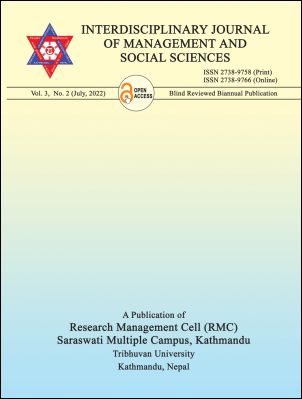Cultural Assimilation Creating Third Culture in Sumnima
DOI:
https://doi.org/10.3126/ijmss.v3i2.50264Keywords:
materialism, spiritualism, liberalism, orthodoxy, staunch, trenchAbstract
Sumnima, a psychological love story between Aryan boy and Kirati girl raises some cultural and philosophical issues of cultural reality of Nepal. Cultural values in Nepal are conflicting but there is a unique understanding and co-ordination between the differing cultural and religious philosophies. Sumnima stands for Kirat's cultural philosophy and Somadattafor Aryan philosophy. Sumnima thinks body to be more important than soul. She believes on materialism, living life and real world. She wants to live with nature discarding all sorts of artificialities and formalities. She does not believe in the life after death. Sumnima is a symbol of materialism whereas Somadatta is of spiritualism. A blind follower of Aryan dogmatic principles, he is guided by Aryan religious, spiritual and cultural philosophy. He believes on eternity and immortality of soul. In course of time, he realizes the importance of Sumnima's culture, her philosophy of life and world. He is serious about his spiritual goals but succumbs to the charms of materialistic world. His son, an Aryan boy, marries Sumnima's daughter, a Kirati girl. Marriage between a boy and a girl of two opposite cultures signifies cultural assimilation and harmonization along with the unity in diversity. It connotes cultural liberalization and reformation in the ancient cultures of Nepal. Abstract ideas of Aryan culture and factual ideas of Kirat culture are integrated to create a new culture that brings the philosophy of materialism and spiritualism, or body and soul together. Cultural liberalism defeats the cultural and religious orthodoxy.

